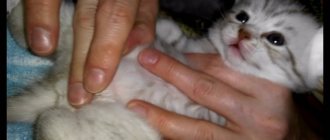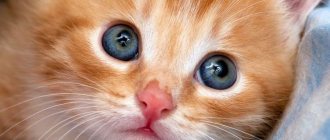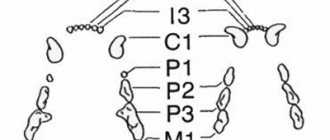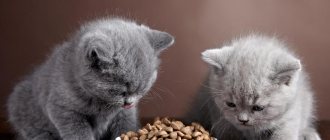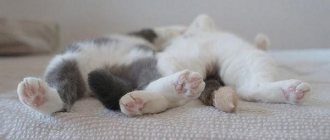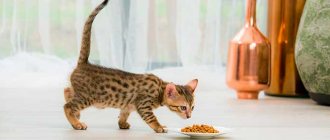Rules for feeding newborn kittens
Teaching a kitten to eat and drink from a bowl is a responsible task for the owner, since a newborn baby, left without a mother and her milk, needs special care and provision of comfortable living conditions.
If such a situation arises, then consultation with a veterinarian is necessary. In this case, newborn kittens are fed from a pipette, and the initial dosage of milk should not exceed more than 2 ml, since they have very small ventricles.
You can teach a kitten to eat from a bowl after three weeks of age, since motor reflexes have formed and he is ready to eat on his own.
Instructions for feeding and introducing complementary foods to newborn kittens:
- after birth, the kitten eats only mother’s milk for the first three weeks (a syringe, pipette with cow’s or goat’s milk is used as a replacement);
- in the period from three weeks to two months, a variety of foods (meat, fish, cereals, legumes) can be introduced into the baby’s diet;
- after four weeks of life, the kitten can be given porridge and pureed vegetables;
- at two months the kitten is ready to eat solid food (bones, cottage cheese, other unground foods);
- after three months, a mature kitten can eat bones, sinews, raw meat, chopped vegetables and fruits;
- After five months, the kitten is ready to eat food that adults eat.
How to teach a kitten to eat on its own?
To learn to feed from a bowl, it is important: the kitten lives with or without its mother.
If the baby is with his mother, then she can teach him everything that is useful in life: to eat, meet the enemy, escape from bad weather. When a cat teaches her baby to eat, she demonstrates to him how she puts her muzzle in a bowl and makes grasping movements, crushes food, and swallows it. A cat often invites its child to eat with its appearance and purring sounds.
The kitten's brain is a sponge, absorbing information from its mother. He is able to repeat everything his teacher shows.
But in practice this is not always the case; many feline maternal responsibilities are taken on by the pet owner.
If you had to do the training, then know that the baby is ready not only to adopt the owner’s eating style, but may also show a desire to brush his teeth like you, or go to the toilet on the toilet. Start learning to feed yourself by personal example.
Show your kitten that you are eating from a bowl on the floor, and he will copy you.
If not, then help him: take the bowl and place it on your lap. Create a cozy environment for your baby. After all, cats are sensitive to spiritual warmth.
Spread food on your pacifier or finger.
Then the baby will remember how he ate his mother’s milk and will lick the food.
When your pet likes the food, his appetite will wake up. Place the rest of the food in a bowl for your baby to see. If his attention is scattered, then he is not hungry or tired. Finish trying to eat.
When you give the kitten food, say about it: “Let's go eat.”
He does not speak and does not understand words, at least not at an early age. But after several days of feeding, the baby is able to remember the word and will show anxiety when pronouncing it. While waiting for food, the kitten may move closer to its bowl.
Sometimes it takes more than a month to achieve a similar result. It is important that the word “eat” is supported by food intake, and without it the eating process does not begin.
Why doesn't it work?
Often the reason for failures when accustoming to independent feeding from a bowl is a new family. After all, kittens are usually raised for up to two months.
For each such animal, this is stress: not only was it taken away from its mother, but it was also given to another family, where there is someone else’s home and unusual rules.
So give the kitten some affection. Try to find a product that your baby will eat with pleasure, despite the foreign environment.
Choose your diet
Try giving your kitten different foods. Only then will you understand what his soul is about. Cats are just as picky about their personal diet as humans and have favorite foods.
Do not leave the room while the kitten is eating. After all, he may feel discomfort without you and will throw food.
How to accustom a kitten to a bowl?
A kitten under two months is not yet smart enough. Therefore, you need to let him try what’s delicious in the bowl. Do this gently by lightly covering your pet's lips with food. You can gently tilt his head into the bowl. It is important that the dishes have a comfortable height.
Try to choose a bowl so that it does not slip on the floor. Place a bowl of water nearby. It happens that a cat (both an adult and a baby) prefers to lap up the water dripping from the tap. Don't interfere with this; on the contrary, support the cat's priorities. Let your pet get comfortable and get used to eating in your home.
A bowl of water is placed next to the food.
Cat dishes should be washed daily, but without detergents.
It is forbidden to overfeed the kitten. It is better when he eats everything that is given to him at a time. Therefore, do not put a lot of food.
When the baby is hungry, he nervously pokes his nose into all the nooks and crannies and squeaks. This is the time to bring it into the kitchen with a bowl of food.
How to accustom a kitten to a change in diet?
You can add new products to those that your baby already enjoys. When the salivary glands begin to function during meals and digestive juices begin to be released into the gastrointestinal tract, the baby will happily eat foods that are new to him.
What can and cannot be given to a kitten?
The kitten is fed kefir after standing for three days in a cool place.
Smoked meats and products containing spices are undesirable for up to five months. But they can be used temporarily for nutrition in the first days of the baby’s stay in the house, if he refuses to eat other food. At the same time, try to mix other products.
From birth, a small kitten sucks milk, which is natural for him. When kittens are taken away from their mother cat, a problem may arise: the kitten wants to eat, but refuses to lap up milk from the bowl. Most likely, he doesn’t know how, and therefore loving owners will need to teach this to their little family member. How to properly train a kitten to lap at home? At what age should I start learning? What do you need for this and how often should you feed the kitten? Let us consider these questions one by one and in detail.
How to train a kitten to eat on its own
In order to teach a kitten to eat from a bowl on its own, you need to make an effort, depending on whether the baby is growing up with or without its mother.
A mother cat teaches her child to eat adult food, check its temperature, she shows him how to swallow food, break it up correctly, and with her purring invites him to a meal.
If the baby grows up without a mother, then the owner needs to teach the kitten to eat independently. In this case, the most effective method is considered to be giving a personal example (showing the baby how to lap milk from a saucer).
An effective method is to smear food on your finger or pacifier. The kitten, in turn, will lick it off and gradually understand that this is how it needs to be eaten to satisfy its needs.
Before a kitten learns to lap from a saucer, it is important to accompany each meal with the phrase “let’s go eat,” since the animal will form a clear reflex to this phrase in the future.
At the same time, obtaining the expected result, when the kitten, having heard the phrase, immediately approaches the bowl, takes time (at least 2 months of daily training).
How to accustom a kitten to a saucer
The most important question is considered here: when and how exactly to accustom a small pet to eating from a saucer and how long such a procedure will take. As mentioned above, a kitten begins to be interested in a bowl when it is approximately three weeks old, or rather, the baby is attracted to the food of its adult counterparts. For this reason, three weeks of age is the best and most suitable for accustoming a kitten to a bowl .
First, you need to pour a little milk into the saucer. Then wet your finger with milk and let the kitten lick it. When he realizes that it is tasty, place the baby near the bowl and carefully dip his face into the milk. At first he won't like it and will pull back, but then he will remember the taste of the milk that he just licked from the man's finger.
At first, the kitten will snort and sneeze incessantly, releasing funny bubbles from the milk. This is due to the fact that he is still mastering the technique of lapping, because not so long ago he did not have to do this - he simply sucked milk from the breast of his mother cat. In addition, sometimes you can notice that he climbs into the bowl with his feet, and such attempts need to be nipped in the bud.
To do this, simply remove it from the bowl, wipe its paws with a napkin and place the kitten next to the saucer. When he starts to climb into the bowl again, hold him back slightly. This way you can teach your pet that its paws should not be in the food.
Why doesn't it work right away?
Many people wonder why it is not immediately possible to teach a kitten to feed from a bowl on its own and should understand that a small kitten that finds itself in a new family takes a longer time to adapt and needs additional care.
In order for the process of accustoming to food to move much faster, you need to diversify your baby’s diet as much as possible. As a result, his taste characteristics will be formed, and he will begin to eagerly eat from the bowl.
During feeding, the presence of the owner is important, since in such conditions the kitten feels comfortable and eats its portion to the end.
How to quickly train a kitten to eat from a bowl
You can teach a kitten to eat from a bowl, if it is artificial, quite quickly using simple techniques:
- a kitten under 2 months of age does not think very well, so in order for him to understand that there is tasty food in the bowl for him, you need to smear his mouth with the mixture or unobtrusively lower his head into the bowl;
- The feeding bowl should not slide on the floor, and a container of water must be placed next to it. It is better to carry out the procedure at the same time, as the animal quickly gets used to the established routine;
- when feeding, do not exceed the servings of food, as in this case the baby’s feeding schedule may be disrupted;
- if the kitten is hungry, then it constantly squeaks, meows and looks for food in a bowl or in various corners of the apartment.
How to teach a kitten to drink from a saucer
An overly hungry kitten will communicate its desire to eat with a loud, shrill squeak. He will crawl fussily and poke his face everywhere, as if looking for his mother cat.
How to teach your baby to eat himself
How often does this happen: a little kitten was brought to a new home, where all the furniture and cutlery had already been equipped for it, but the baby refuses to eat. For babies separated from their mother early, this condition is natural. The kitten didn’t even think about the fact that there was food other than mother’s milk. Even when he is hungry, he does not know how to eat himself and does not understand why his owner demands the impossible from him. You will have to try to teach the kitten to eat on its own.
It is best to start with milk - this is the only food that the baby currently knows. Warm cow's milk needs to be heated to a comfortable temperature and filled into a bowl. Be patient! A fluffy toddler can wander around a bowl for a long time, sniffing the contents incredulously and periodically backing away. Help the baby. You can soak your fingers in milk, then run them over the kitten’s face, or lightly poke its nose into the bowl. A clean baby will immediately begin to lick itself and snort, but at the same time it will like the taste of warm milk. Not immediately, but after several such shenanigans, the baby will understand how great it is to eat on his own.
It will be more difficult to teach a kitten to eat if the bowl is uncomfortable or not very clean and contains foreign odors. An ideal cat dish should smell only of fresh, warm food, not slide across the floor, and not force your pet into an awkward body position.
As soon as the fluffy bastard learns to drink milk on his own, it will be possible to switch him to porridge and baby food. Meat pate for kittens would be a good delicacy, but not all kids will immediately start tasting it. Some cubs need time to adjust to new food.
Owners use different tricks to get their pet to eat new delicacies. Sometimes they mix innovations with familiar food, and the kitten, without knowing it, becomes accustomed to various unfamiliar dishes. You can bring new food on your finger to the kitten's face. Sometimes the picky person plucks up courage and tries what the owner suggested.
Useful nuances
Every happy owner should know these little things:
- A kitten of any age should always have access to clean water. You need to change the contents of the water bowl 2-3 times a day. Sometimes hair and food debris get into the water, which can cause the animal to refuse to drink and suffer from thirst.
- Kittens can get into the bowl with their paws, you can’t scold them for this. This is how kids enjoy the delicious food given by their beloved owner. If a person scolds a pet, the cat develops a fear associated with eating, and this then affects the upbringing of the baby.
- If your baby relieves himself regularly, it means he is getting enough food.
And most importantly: you don’t need to worry too much. There are no cats who would prefer to live on milk all their lives. Sooner or later, the pet will stop its tricks and start trying new things.
How to change a kitten's diet
A variety of diet is provided gradually after the first three weeks of a kitten’s life, which helps improve the functioning of the digestive system, and the baby begins to enjoy eating food.
List of approved products for small kittens:
- low-fat kefir aged three days;
- smoked meats can be used as a flavoring additive to food to develop a stable reflex to food intake in an animal;
- liquid porridges, vegetable purees;
- boiled meat in small pieces.
If more than 5 months have passed since the birth of the kitten, then it can eat a variety of foods in normal quantities, like an adult animal. Mature individuals have well-developed digestion, teeth have formed, so they are completely ready for adult life.
How to teach
Need a comfortable bowl for lapping milk
- Prepare a small bowl.
- Place a small towel around it.
- Heat the milk to body temperature and pour a small portion into a bowl.
- Place the kitten near the bowl and gently dip its face into the milk.
- Try to repeat the procedure several times.
Second way of learning:
- Take a tablespoon.
- Pour warm milk into it.
- Bring it to the kitten’s face and dip it in milk.
- Hold the spoon at muzzle level so that the kitten has no choice but to start lapping up the milk.
Price: 723 rub.
780 rub.
7% discount for you!
Stretches out the animal's food intake. Fast delivery throughout Russia. And also more than 3,000 other pet products at competitive prices!
How to feed a newborn baby
An important aspect is to ensure the correct feeding schedule for newborn kittens who are left without a mother. In such cases, it is necessary to follow simple recommendations:
- It is convenient to feed a kitten with cow's milk from a pipette up to 8 times a day (the temperature of the mixture should not exceed 37 degrees). The temperature is checked by pouring a drop of milk onto the back of the hand;
- if the kitten has reached the age of 1 month, then for feeding you can use a regular bottle with a nipple;
- After each feeding of the newborn, it is recommended to massage the tummy to improve digestion (light strokes clockwise);
- A qualified veterinarian can create an individual diet that will help quickly establish the baby’s digestive process.
Age aspects of the cat “table”
Now we will look at how soon kittens begin to eat on their own. Until the kittens are at least a month old, they need to be fed 8 times a day
. The milk should be low-fat and slightly warmed; it must first be heated to approximately 37 degrees. To check the temperature, you need to drop milk on the outside of your palm. Until the kitten reaches two weeks of age, it is more comfortable to feed it from a pipette.
When the cat is three weeks old, you can try switching to a bottle with a nipple. After the baby has eaten, a simple abdominal massage is performed. This is necessary for the digestive system to function properly. When the pet is 1-1.5 months old, it must receive liquid food 5-6 times a day. The baby is allowed to give the following foods:
- children's meat and vegetable nutrition;
- semolina without sugar;
- boiled yolk;
- low-fat cottage cheese.
When your pet is 2 months old and the first baby teeth have begun to grow, you are allowed to start giving your baby solid food. However, at the same time, you should not exclude liquid food, because it is very beneficial for the kitten’s digestive system. It is important to remember that the kitten develops quickly, increases in size, and every day its need for nutrients also increases. The better a baby eats at a given age, the stronger his health will be as a result. By 2 months it is allowed to start giving the following products:
- lean boiled meat;
- cottage cheese;
- cereals;
- chicken yolk;
- milk and dairy products;
- natural yogurt.
To prevent the kitten from becoming wayward in the future, it is necessary to accustom it to the correct table when the kittens begin to eat themselves. It is not uncommon for cats to begin to eat only a certain type of food and refuse the rest - no less necessary. One regular meal cannot contain all the vitamins and nutrients suitable for a cat. And if you want your pet to be unpretentious in food, teach him cereals, fruits and vegetables from early childhood.
Now we come to the most basic question: how quickly and how to teach a baby to eat without the help of others and how long it will take.
As mentioned earlier, kittens become interested in eating on their own at three weeks of age, or rather, they show curiosity about the food of adult cats.
Therefore, this particular age is considered one of the best for teaching a baby to eat from a saucer.
First you need to pour warm milk into a saucer, just a little. Then dip your own finger and let your baby lick it. When the kitten understands that it’s tasty, you need to put the baby near the plate and dip his face directly into the milk. At first he will back away, but when he starts licking himself, he will remember the taste of the milk that was previously given to him on his finger.
At first, the kitten will snort and sneeze without stopping, releasing funny bubbles from the milk. This happens due to the fact that he is just mastering the technique of lapping, because not so long ago he had not had the opportunity to do this - he simply sucked milk from the breast of a mother cat. In addition, from time to time you can see that he himself climbs into the bowl with his feet, and these attempts must be stopped immediately.
To do this, simply remove it from the bowl, wipe its paws with a napkin and place the kitten next to the saucer. When he starts to climb into the bowl again, hold him back a little. This way you can teach your pet that his paws should never be in food.
Why might a kitten refuse food?
From time to time the pet refuses to eat on its own. This may happen because you started teaching him to eat on his own too early. In this case, it is better to start feeding the kitten with a pipette again or return it to the cat. After some time, you can again try to teach the kitten to eat on its own.
The kitten will not be able to start eating without the help of others if the bowl is very large or unstable, since the kitten will simply be uncomfortable. Buy him a bowl that fits his size and is stable on the floor. Then the little animal will begin to feel comfortable and will be more willing to eat.
The kitten may not like the food if it is very hot or cold
.
The kitten should be fed food that is not very hot, preferably at room temperature. Moreover, the baby may have problems with well-being. Because of these problems, the kitten will not be able to feed on its own. If you notice the first signs that indicate this, it is better to immediately contact your veterinarian
.
Some rules to help you in this matter
There are quite a few opinions about what is best for a kitten and how to start teaching it to feed itself
. However, there are rules that must be followed:
- The saucer should always be clean and suitable for a small kitten.
- There should be a bowl of water next to the food bowl.
- Feed your kitten according to its age and needs. If required, with the permission of the veterinarian, you can give your baby vitamins.
- If your baby goes to the toilet often, it means he has enough food.
- Do not force your baby to eat.
- Do not mix dry food and natural food (except in cases where a transition from one food to another is necessary).
- After your pet has eaten, you can massage its belly so that the digestive system starts working.
- There needs to be a clear separation between the playing and eating areas.
A little persistence and understanding, and within a week your little pet will learn to eat without help
others.
And it’s no longer so important when you teach your pet to eat from a bowl, the main thing here is patience. You just need to give him time to get used to food, different from his mother’s milk. And the most important thing: no need to worry too much. There are no cats that would prefer to eat only milk all their lives. Over time, your pet will stop being mischievous
and start trying new things.
It might be useful to read:
- How is the love of a man different from the love of a woman? ;
- Virtual relationships: types, pros and cons, expert advice;
- What does the word deleted mean? What does deleted mean in contact;
- ;
- Mods for Minecraft (Minecraft);
- Procedure when a package has been stolen at the post office Difficult, but possible;
- How can you turn into a mob in Minecraft? ;
- Stomach pain causes and treatment;
Recommendations for training a kitten yourself
Most often, problems with independent feeding in a kitten arise if it is separated from its mother at an early age, since it is she who teaches her offspring to lap from a bowl without problems and in a fairly short time.
If such nuances arise, experts give some recommendations:
- Bowl feeding begins with cow's milk, which is served warm. It is necessary to offer the kitten food and let it smell it. If he is not interested, then you can lightly poke him with his muzzle to fully experience the taste of the product;
- in some cases, the food bowl is not suitable in height, so it is best to purchase it from a special pet store in accordance with the appropriate parameters;
- after the kitten has learned to lap up milk from a bowl, you can gradually switch it to semolina porridge;
- Meat pate for kids is often tried as a new product that can be used during training. At the same time, the reaction to it is ambiguous (some kittens immediately try and eat the product, while others refuse food until they grow up);
- When eating, the kitten must also be given water, since the animal requires mandatory fluid intake, especially after a meal;
- in many cases, small pets love to bathe in a bowl of milk. At the same time, there is no need to limit such actions, since over time, kittens learn to eat well on their own;
- A kitten's normal nutrition can be assessed by the number of trips to the litter box. If they are regular, it means that the pet is well fed, and its digestive system is working stably.
How to teach a kitten to eat on its own? When do kittens start eating on their own?
When a kitten appears in the house, the owners stock up on fresh milk, food and bowls, but he refuses to eat, although he is hungry, what to do in such a situation? Of course, you need to teach the kitten to eat on its own.
Problems with nutrition most often arise in those kittens that were given too early to be raised by their owners and taken away from their mother, who gave him breastfeeding, and he has not yet learned to eat on his own. You need to start learning with milk. Heat the milk a little and pour it into a bowl. How to teach a kitten to eat on its own? Place the bowl next to the kitten and dip his face in the milk, he will be forced to lick his lips and taste the taste of the milk.
Try until the kitten becomes interested and starts eating on its own. Sometimes, kittens refuse to drink because the bowl is very low and the kitten has to bend over, so keep an eye on this issue and place the bowl on a stand.
When your baby learns to drink milk, offer him to eat meat pate for kittens. You need to put a little pate on your finger and bring it to the baby’s mouth, he will smell the smell and want to try new food. If the kitten licked the pate, then put some in a bowl.
The kitten should not be given dry food or solid food in large pieces. Try to grind and chop all the food and gradually give it in small portions for testing. You just need patience, and your pet will eat well on its own. When do kittens start eating on their own? This happens after several workouts.
Food for cats is pureed soups, meat broths, milk, meat in small pieces (boiled only), special food for kittens and canned food. Food should not put too much strain on the kitten’s stomach, but it must be eaten. You can give your cat a hard-boiled egg yolk, broth, boiled potatoes, boiled fish, or preferably boiled beef. Special canned food for kittens is balanced and makes the gastrointestinal tract soft.
Be sure to give your baby water, let him drink as much as he needs. There are kittens that don’t drink much, but there are others who don’t drink much. Cats are very sensitive to the cleanliness of bowls, so wash all of your kitten's bowls. Change the water regularly to encourage your kitten to drink.
How can you tell if your pet is eating normally? Only by tray. If the baby goes to the tray regularly and normally, then you are feeding him normally. Each animal has its own food consumption rate.
It is best not to introduce your kitten to dry food, as later problems with the intestines and stomach may arise.
How to teach a kitten to eat solid food on its own
In some cases, problems may arise when introducing solid food into a kitten’s diet, so you need to follow these simple rules:
- You can try placing small pieces of food directly into the kitten’s mouth. This way he will taste the product and subsequently will not refuse it, but will eat it with pleasure;
- As an initial complementary food, you can use dry food, which is pre-soaked in water. The initial quantity should not exceed 2 pieces;
- When introducing solid foods, you need to pay attention to the baby’s taste preferences (some kittens love cottage cheese, while others are delighted with fish). Based on the information received, a daily diet is compiled;
- It is recommended to start introducing solid foods with liquid porridges (semolina or crushed corn grits are considered the best option);
- dry forms are given to small kittens only after all their teeth have formed.
Kittens begin to eat on their own when they reach the age of 1–1.5 months. Before this time comes, you should try to teach your pet to drink milk and gradually diversify its diet by introducing other products.
How to teach a kitten to drink water from a bowl or jar
Many owners don’t know how to teach a kitten to drink water from a bowl; they try to poke it with its muzzle into the container , but this scares the pet. Use tall, dark dishes that won't confuse your cat with bright colors.
Bottled or filtered tap water contains the necessary elements to support metabolic processes
Try to entice them with a game: sprinkle a few drops with your fingers or a spray bottle. The kitten will become interested in splashing water, water circles in a bowl, and out of curiosity wets its paw into the container.
Be sure to read:
How to reconcile cats living in the same apartment: several ways to make pets friends
This may frighten him, but try to reassure your baby that the liquid in the bowl is safe. Repeat the above methods, then he will get used to the bowl.
Attention! If the kitten is vomiting severely, you will have to force liquid into it using a syringe to prevent dehydration.
Another option will also help accustom your cat to the bowl: use catnip. Place the container on a cloth soaked in the liquid extract, and the cat will not remain indifferent to its smell. Try not to overdo it with mint: animals' sense of smell is much more subtle than human perception of odors.
The easiest way is to arrange dishes of different shapes and observe which bowl the kitten pays more attention to. Most importantly, don't stand next to him and don't force him to drink. Your presence can distract the cat or frighten it.
Important! Often cats drink water from the shower or sink because they are interested in it.
Additional Tips
Kittens at a young age eat small amounts of milk, so a regular plastic lid for cans would be a convenient container for them. It is difficult for a kitten to learn to feed itself in a large bowl, since the milk is distributed unevenly, and the animal simply bathes in it.
Milk for feeding should be at room temperature, as too cold or too hot a formula can adversely affect the health of a small pet. You can heat the product using any available methods (microwave, regular heating), but it is important to check the degree of heating itself (no more than 37 degrees).
At first, a pipette, a syringe, or a container for nasal drops are used as a feeding device for a newborn kitten. The container must be thoroughly washed and sterilized before first use.
A kitten that lives with its mother quickly gets used to eating from a bowl after the cat, since she independently ensures that the offspring acquires all the necessary skills. Therefore, it is better to adopt a small pet after two months of age, when it is completely ready for life in a new home and easily adapts.
How to determine if your cat drinks enough fluid per day
Animals have the same problems as humans when they don't get enough fluids. Cats may not get the moisture they need for a variety of reasons, but owners should closely monitor their pet's health.
Be sure to read:
How to stop a kitten from shitting anywhere: the best ways, when to teach it, why it doesn’t go to the litter box
The following signs may indicate your pet's condition:
- Skin elasticity . Your pet's skin becomes dry and stiff if he doesn't drink enough fluids. Normal dermis quickly regains its shape if you grab the cat's scruff and pull.
- Condition of the coat. It is worth sounding the alarm when the cat’s fur loses its shine and begins to fall out. If the animal does not have parasites or allergies to the selected diet, then the problem may lie precisely in the lack of moisture. When a pet's coat is shiny, it makes it clear that its health is not in danger.
- Physical activity. Without the necessary moisture, the cat becomes inactive, reacts sluggishly to calls, and does not want to play.
- Frequency of urination . If an animal urinates less than 2 times a day, this is a sign of ill health.

